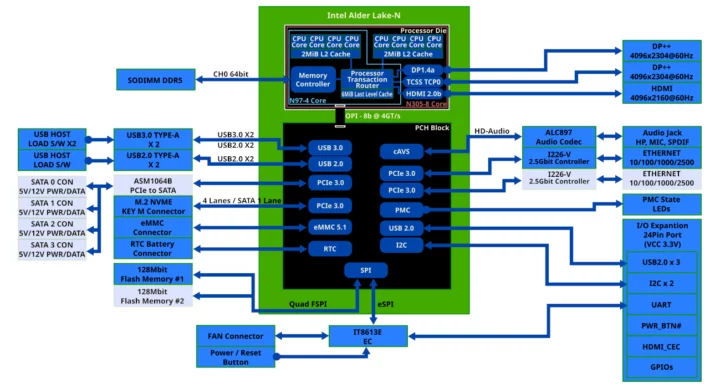Hardkernel has just launched an upgrade to their ODROID-H3/H3+ Jasper Lake SBC, with the ODROID-H4, ODROID-H4+, and ODROID-H4 Ultra boards powered by Intel Processor N97 or Intel Core i3-N305 Alder Lake N-Series processors.
The ODROID-H4 family supports up to 48GB DDR5-4800 memory and NVMe SSD storage, comes with up to two 2.5GbE, four SATA III ports, three 4K capable video output ports (HDMI and DisplayPort), a range of USB ports, and a 24-pin GPIO header.
ODROID-H4 specifications compared to previous generation ODROID-H2+ and ODROID-H3 boards.
| ODROID H2+ | ODROID H3 | ODROID H3+ | ODROID H4 | ODROID H4+ | ODROID H4 Ultra | |
|---|---|---|---|---|---|---|
| CPU | Intel Celeron J4115 quad-core processor up to 2.5 GHz | Intel Celeron N5105 quad-core processor up to 2.9 GHz | Intel Pentium N6005 quad-core processor up to 3.3 GHz | Intel Processor N97 quad-core processor up to 3.6 GHz | Intel Processor N97 quad-core processor up to 3.6 GHz | Intel Core i3-N305 octa-core processor up to 3.8 GHz |
| AVX2 support | No | No | No | Yes | Yes | Yes |
| TDP | 10W | 10W | 10W | 12W | 12W | 15W |
| iGPU | 12EU up to 750 MHz | 24EU up to 800 MHz | 32EU up to 900 MHz | 24EU up to 1200 MHz | 24EU up to 1200 MHz | 32EU up to 1250 MHz |
| Max memory | 32GB DDR4-2400 | 64GB DDR4-2933 | 64GB DDR4-2933 | 48GB DDR5-4800 | 48GB DDR5-4800 | 48GB DDR5-4800 |
| M.2 PCIe socket (for SSD or quad 2.5GbE add-on) | PCIe Gen2 x4 | PCIe Gen3 x4 | PCIe Gen3 x4 | PCIe Gen3 x4 | PCIe Gen3 x4 | PCIe Gen3 x4 |
| SATA III | 2 | 2 | 2 | None | 4 | 4 |
| Video Outputs | HDMI and DisplayPort | HDMI and DisplayPort | HDMI and DisplayPort | HDMI and 2x DisplayPort | HDMI and 2x DisplayPort | HDMI and 2x DisplayPort |
| Audio | 3.5mm audio output and input jacks, optical S/PDIF | 3.5mm audio output and input jacks, optical S/PDIF | 3.5mm audio output and input jacks, optical S/PDIF | 3.5mm audio output and input jacks, optical S/PDIF | 3.5mm audio output and input jacks, optical S/PDIF | 3.5mm audio output and input jacks, optical S/PDIF |
| 2.5GbE | 2 | 2 | 2 | 1 | 2 | 2 |
| USB | 2x USB 2.0 + 2x USB 3.0 | 2x USB 2.0 + 2x USB 3.0 | 2x USB 2.0 + 2x USB 3.0 | 2x USB 2.0 + 2x USB 3.0 | 2x USB 2.0 + 2x USB 3.0 | 2x USB 2.0 + 2x USB 3.0 |
| 24-pin GPIO header | Yes | Yes | Yes | Yes | Yes | Yes |
| TPM 2.0 | No | Yes | Yes | Yes | Yes | Yes |
| Dimensions | 110x110mm | 110x110mm | 110x110mm | 120x120mm | 120x120mm | 120x120mm |
| Price at launch | $119 | $129 | $165 | $99 | $139 | $220 |


The GPIO header offers the following interfaces for all models except for the ODROID-H2+: 2x I2C, 3x USB 2.0, 1x UART, 1x HDMI-CEC, ext. power button. The H2+ header has similar interfaces, but only one USB 2.0 and two UART. Some may note the maximum RAM capacity numbers differ from the data on Intel Ark, but the latter is not usually correct, and Hardkernel have tested their board up to the reported capacities. Users can still use the quad 2.5GbE Net Card to create a system with six 2.5GbE ports.
Some new features not listed in the specifications include a dual BIOS (ODROID-H4+ and ODROID-H4 Ultra only) in case the BIOS is corrupted during an update (e.g. because of a power outage), new types of cases so that a cooling fan can be mounted inside the case, and mini ITX kit for use with standard PC cases.

Hardkernel also shared several benchmarks (and lots of information) comparing the different ODROID-H models including the compression/decompression benchmarks (7-Zip, xz, bzip2…) shown below with or without the “Unlimited Performance” mode – shown as UP in the chart – where the CPU can run in Turbo Boost mode with no time limit. All tests were performed on Ubuntu 22.04.3/4 (Gnome).
Those interested in GPU performance may be interested in the video below showing some games in action.
The ODROID-H4, H4+, and H4 Ultra can be purchased now for respectively $99, $139, and $220 with shipping starting next week. That’s for the board only, and you’ll need to add a power supply, SATA cables, memory, storage, a slim cooling fan, and potentially one of the cases compatible with the ODROID-H4 board with up to four 3.5-inch SATA drives.

Jean-Luc started CNX Software in 2010 as a part-time endeavor, before quitting his job as a software engineering manager, and starting to write daily news, and reviews full time later in 2011.
Support CNX Software! Donate via cryptocurrencies, become a Patron on Patreon, or purchase goods on Amazon or Aliexpress






